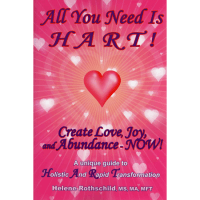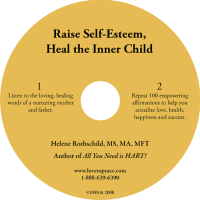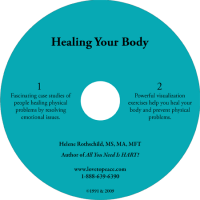Releasing Anger
By Helene Rothschild
(Excerpts from the book and e-book, “All You Need Is HART! Create Love, Joy and Abundance-NOW!” A unique guide to Holistic And Rapid Transformation)
Many people are joyously singing “Let there be peace on earth and let it begin with me.” I love that song and I totally believe in what it is telling us. I am convinced that when we human beings who inhabit this world experience inner peace, then, and only then will we actualize long lasting world peace.
I used to feel so powerless when I read the horrible stories in the newspaper. However, then I realized how powerful I am to change the world when I focus on changing myself and helping others to grow also. I became aware of the inner turmoil in myself and others that prevents us from feeling peacefully powerful. I kept exploring what we need to do in order to end our internal wars and experience inner peace.
As a growing person and a psychotherapist, I have discovered that one important thing we have to learn in order to experience inner peace is how to deal with our own personal anger. This human emotion is often denied, misunderstood, and misused. It is dangerous for us and the world when we don’t constructively express this human emotion. The following is what I have learned about dealing with anger.
1. What is anger?
Anger is a normal, healthy human emotion. Whenever you are experiencing anger, you are also feeling fear, hurt, and/or powerlessness. Therefore, when you deal with your anger, you also need to deal with all the underlying emotions.
2. Where in your body do you feel anger?
Most people feel anger in the form of tension or pain in their forehead, jaws, cheeks, temples, arms, hands, center of the back of the neck, and the back (especially the shoulder blades and the lower back).
3. What are some physical problems or illness that may result from
suppressed anger?
Some physical problems that may indicate that anger is present are: headaches; jaw, gum and teeth problems (from grinding the teeth); arthritis in the fingers or hands; back problems; stroke and heart attack (“I am busting a gut”); high blood pressure (“I am boiling”); bursitis in the shoulder (“I want to hit someone”); constipation; and extreme tiredness. (Note: depression is anger turned inwards. When you release your anger in a constructive way, your depression may also be released.)
4. Is anger a good (positive) or bad (negative) emotion?
Anger is one of many emotions (feelings). Emotions are not good or bad, positive or negative. They are feelings that have to be expressed. People have the choice of dealing with anger in a positive or negative way (constructively or destructively).
5. How do people express anger in a negative way?
Some people act out their anger in what is called Active Aggression. Others act it out in Passive Aggression. And some people alternate between active and passive aggression.
Active Aggressors may shout, curse, or physically
attack a person or a thing. Some examples are: hitting, rape, murder,
starting fires, and defacing property.
Passive Aggressors may quietly withdraw, be late, be
sarcastic, procrastinate, forget important dates, verbally attack with a
soft voice and a smile, or overeat.
6. Does physical activity help release anger?
Physical activity helps relieve some of the angry energy that results from angry feelings, but it does not resolve the anger. Therefore, the angry feelings still present will create more angry energy, and you have to keep running faster or hitting the ball harder in order to keep from exploding.
7. Why do most people deny or resist accepting their angry feelings?
Most people block their anger because they are afraid that if they are
angry they will:
1 hurt someone else or themselves
2 be hurt by someone else
3 be out of control or crazy
4 be wasting their time (“I don’t accomplish anything, so why
bother?)
5 be bad or not O.K.
6 be unladylike
7 be rejected
8 be like their parent and they hated it when their parent was angry
9 be too powerful
10 be giving their power to the other person (“The other person will
know they won or got to me.”)
8. How can I deal with my anger in a positive way?
You can deal with your anger in a constructive way by first acknowledging it. Then by yourself or with someone you trust, angrily yell and hit a soft pillow until your anger is released. After that, get in touch with an underlying feeling which may be fear, hurt, or powerlessness. Once you have owned and expressed all your feelings, you are ready to make an affirmation (a positive thought).
For example:
1. If you are angry when “J” comes home late, release your feelings by hitting a soft pillow, as you say “I’m angry at you ‘J’ for being late. I’m angry.” (Continue to yell until you feel relaxed.)
2. Then say to yourself, “When you are late, I’m scared that I’m
unimportant.”
3. Affirmation: “I’m beginning to believe that I’m important.”
4. If you are feeling calm because you understand all your feelings and
have released them, decide if you need or want to talk to the person about
the issue of coming late-in person, by letter, or by phone.
5. Finally, compliment yourself for dealing with your anger in a
healthy, positive, and constructive way.
REWARD YOURSELF! YOU DESERVE IT!
©1999 & 2007 by Helene Rothschild, MS, MA, MFT, Marriage, Family Therapist, intuitive counselor, author, and speaker. The article is excerpts from her new book, “All You Need Is HART! Create Love, Joy and Abundance ~NOW!” A Unique Guide to Holistic And Rapid Transformation. She offers international phone sessions, teleclasses, independent studies, books, e-books, MP3 audios, CDs, reports and free newsletter. Receive a free MP3 of a teleclass, “Healing Your Body” and e-book. www.lovetopeace.com.



